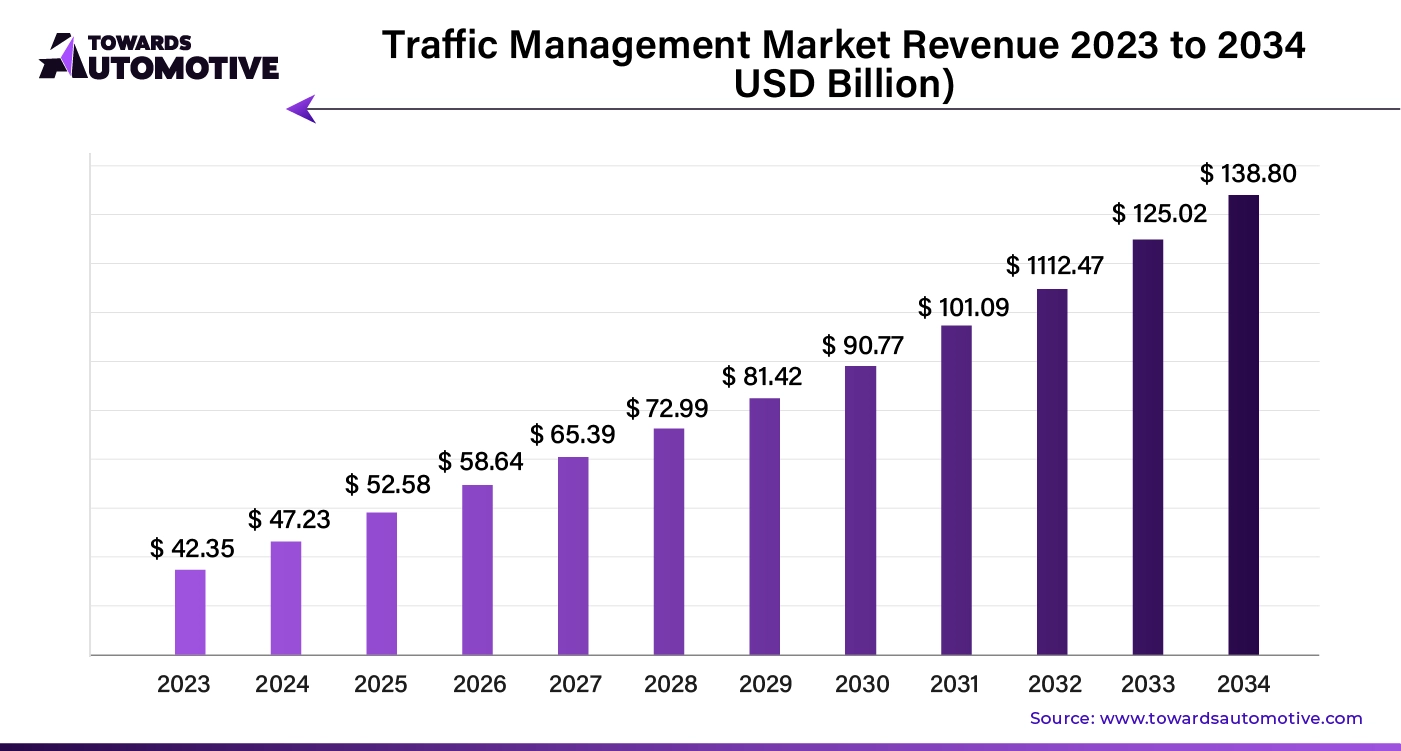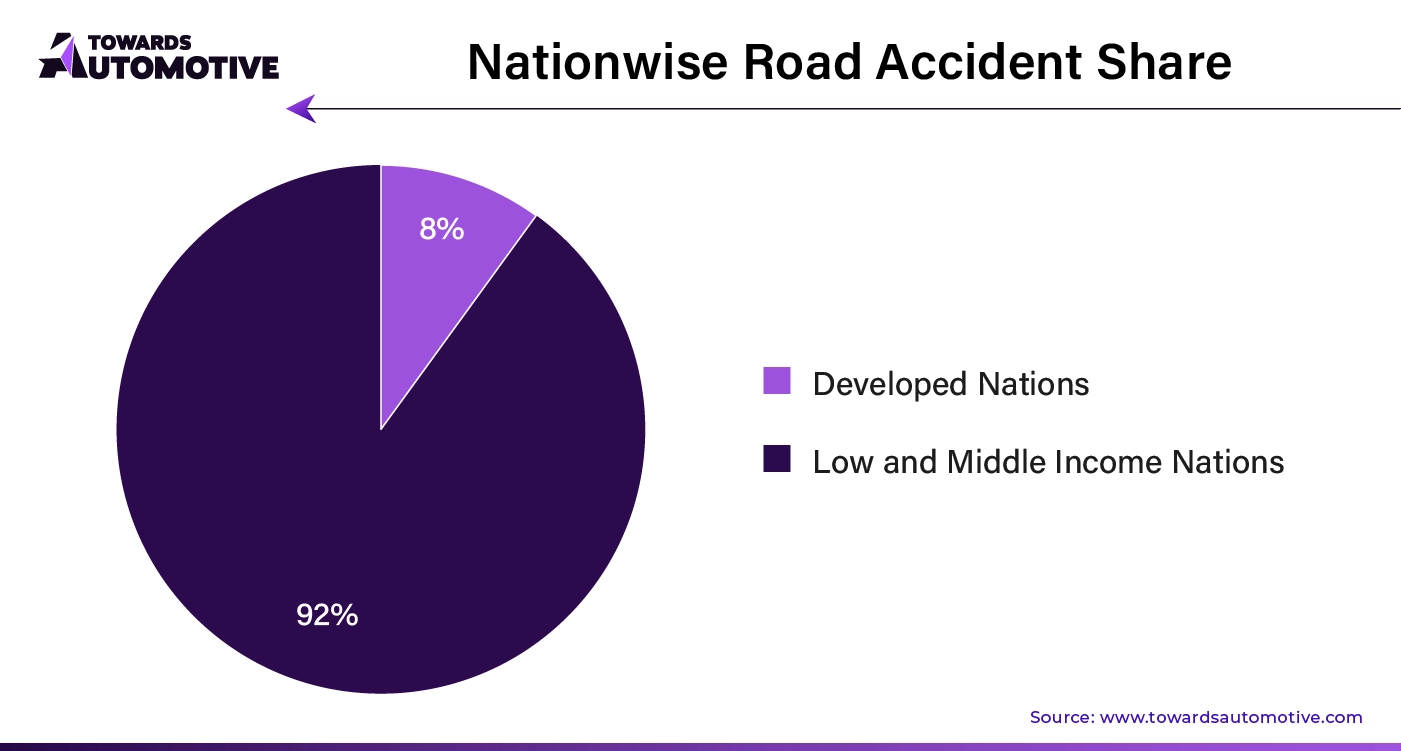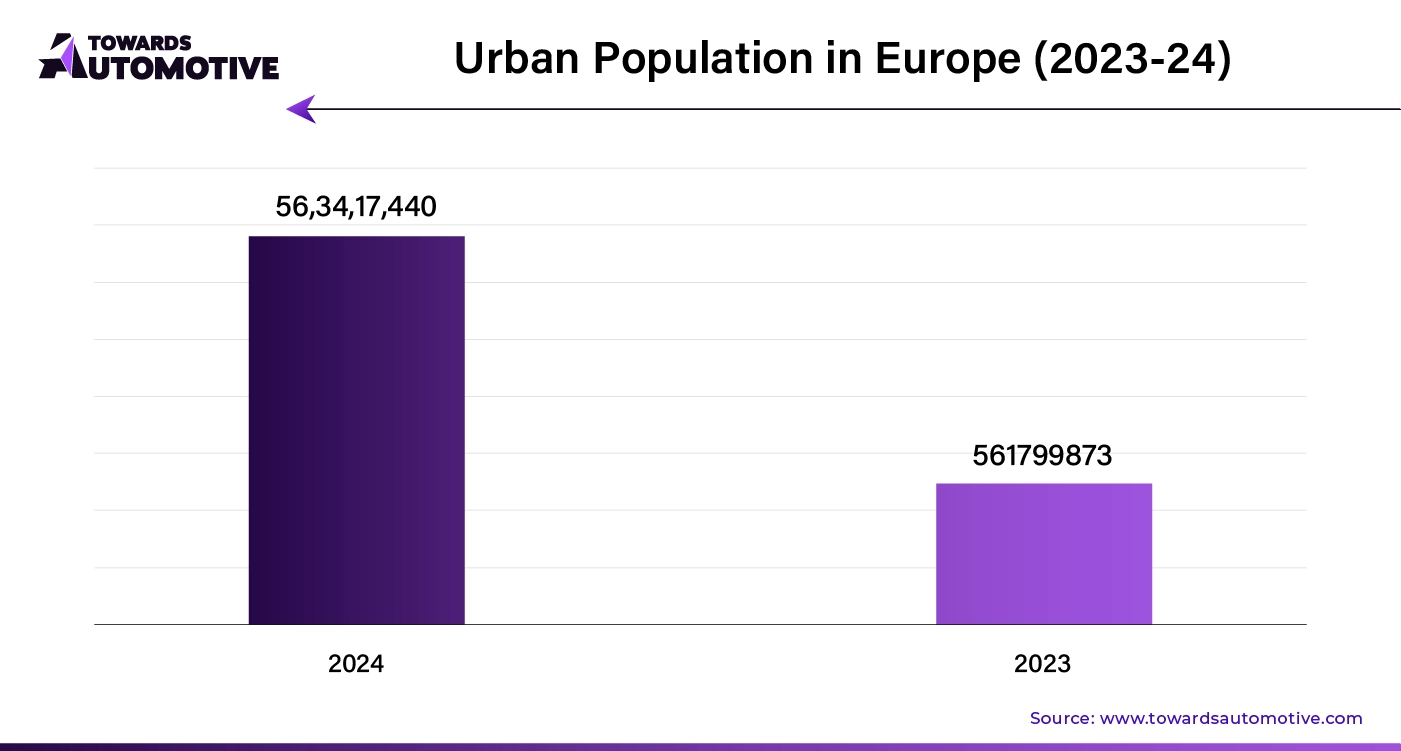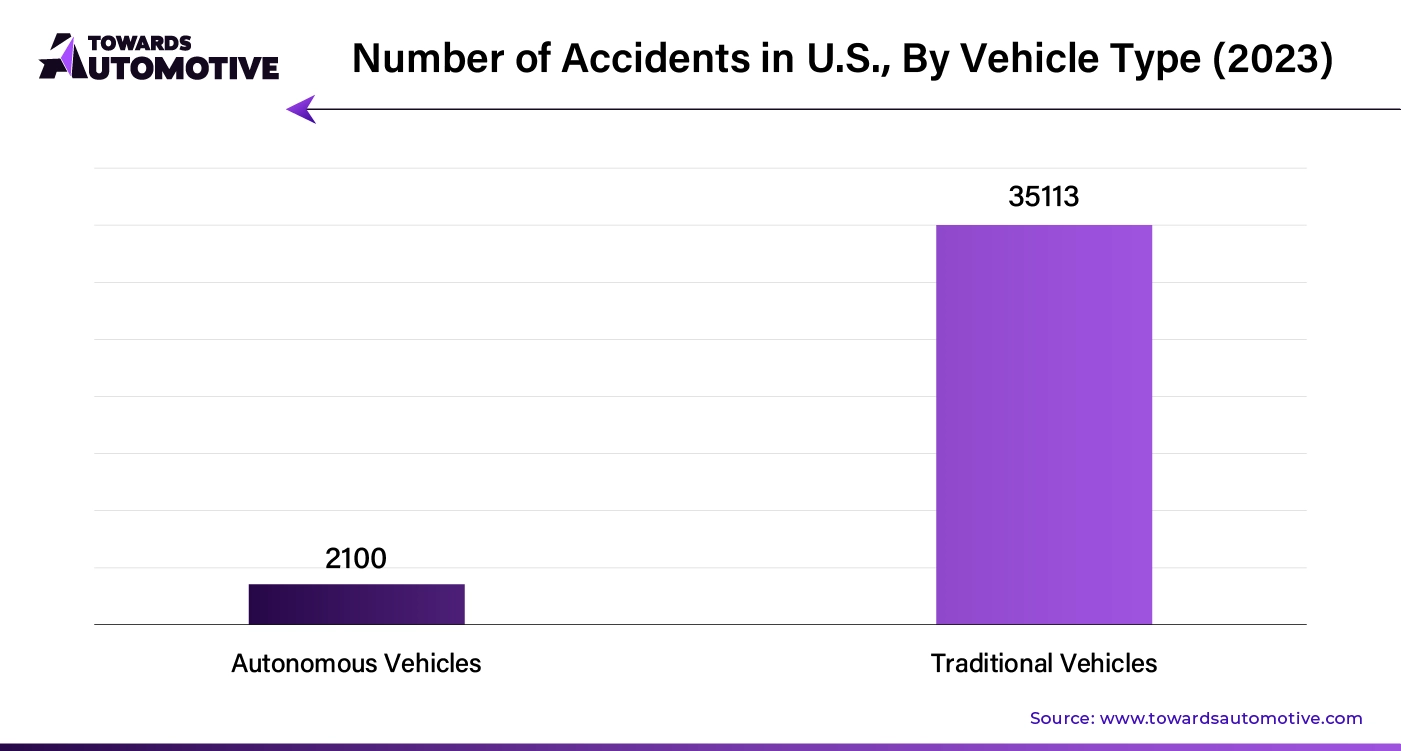March 2025
The global traffic management market size is calculated at USD 47.23 billion in 2024 and is expected to be worth USD 138.80 billion by 2034, expanding at a CAGR of 11.44% from 2024 to 2034.

Unlock Infinite Advantages: Subscribe to Annual Membership
The traffic management market is a dynamic and rapidly evolving sector focused on optimizing the flow of vehicles and pedestrians to enhance urban mobility and reduce congestion. As cities around the world grapple with increasing populations and expanding infrastructure, effective traffic management becomes crucial in maintaining smooth and efficient transportation networks. This market encompasses a range of technologies and solutions designed to address traffic congestion, improve road safety, and streamline transportation systems. Key components include intelligent transportation systems (ITS), traffic signal control systems, real-time traffic monitoring, and advanced data analytics.
Technological advancements, such as artificial intelligence (AI), Internet of Things (IoT), and machine learning, are driving innovations in traffic management. These technologies enable more sophisticated traffic prediction and control, allowing for dynamic adjustments to traffic signals, optimized routing, and better incident management. Additionally, the integration of smart infrastructure, such as connected sensors and automated traffic cameras, enhances the ability to gather and analyze traffic data in real-time.
As urban areas continue to grow and evolve, the need for efficient traffic management solutions becomes increasingly vital. The traffic management market is poised for significant growth, driven by the demand for smarter, more connected, and data-driven approaches to managing the complexities of modern transportation networks.
Artificial Intelligence (AI) plays a pivotal role in transforming the traffic management market by significantly enhancing the efficiency and effectiveness of transportation systems. AI-driven solutions enable advanced traffic prediction and forecasting by analyzing historical and real-time data to anticipate congestion and optimize traffic flow. Through adaptive traffic signal control, AI dynamically adjusts signal timings based on real-time conditions, reducing wait times and mitigating bottlenecks at intersections. AI also improves incident detection and management by quickly identifying and responding to accidents or disruptions through analysis of video feeds and sensor data.
Additionally, AI optimizes routing and navigation, providing real-time recommendations that help drivers avoid congestion and streamline their travel. Smart parking solutions powered by AI guide drivers to available parking spaces, reducing time spent searching and minimizing congestion. Furthermore, AI supports the integration of autonomous vehicles into traffic systems by facilitating communication with other vehicles and infrastructure. Overall, AI enhances traffic management by providing real-time insights, dynamic adjustments, and predictive capabilities, leading to smoother, safer, and more efficient transportation networks.
The rising emphasis on public safety is a significant driver of growth in the traffic management market, as cities and governments prioritize enhancing road safety and reducing traffic-related accidents. With increasing urbanization and vehicle density, ensuring safe and efficient transportation systems has become a critical concern. Advanced traffic management solutions are being developed and deployed to address these challenges, including intelligent transportation systems (ITS), real-time monitoring, and automated incident detection. These technologies improve public safety by enabling quicker response to accidents, optimizing traffic signal timings to reduce congestion, and providing drivers with real-time alerts about road conditions and hazards.
Furthermore, innovations such as AI-driven traffic analytics and connected vehicle technologies enhance safety by predicting potential risks, managing traffic flow, and integrating with other safety infrastructure. The focus on public safety also drives investments in smart infrastructure, such as enhanced road signage, pedestrian crossings, and surveillance systems, all aimed at creating safer travel environments. As safety concerns continue to grow, the demand for advanced traffic management solutions that can effectively address these issues and improve overall road safety is expected to fuel continued market expansion.

The traffic management market faces several restraints that impact its growth. High implementation and maintenance costs for advanced traffic management systems can be prohibitive, particularly for smaller municipalities and developing regions. Additionally, the integration of new technologies with existing infrastructure poses technical challenges and requires substantial investment. Data privacy and security concerns also arise with the collection and analysis of large volumes of traffic data. Furthermore, the rapid pace of technological change can lead to obsolescence, making it difficult for organizations to keep systems up-to-date. These factors collectively hinder the widespread adoption and expansion of traffic management solutions.
Vehicle-to-Everything (V2X) communication is creating significant opportunities in the traffic management market by revolutionizing how vehicles interact with their surroundings. V2X technology enables vehicles to communicate with infrastructure, other vehicles, and pedestrians, facilitating real-time information exchange that enhances traffic flow and safety. By integrating V2X communication into traffic management systems, cities can implement advanced traffic control strategies that reduce congestion and improve overall efficiency. For instance, V2X can dynamically adjust traffic signals based on real-time data from vehicles, optimizing signal timings and minimizing delays at intersections.
Additionally, V2X enhances incident detection and response by providing timely alerts about accidents or road hazards, enabling quicker emergency responses and reducing the impact on traffic flow. The technology also supports the deployment of autonomous vehicles by providing them with critical information about road conditions and other road users, ensuring smoother and safer integration into existing traffic systems. Furthermore, V2X communication contributes to the development of smart infrastructure, such as intelligent traffic signs and connected sensors, which further enhance traffic management capabilities. Overall, V2X communication opens new avenues for improving urban mobility, making transportation systems more efficient, responsive, and safer.
The surveillance camera segment held the largest share of the market. Surveillance cameras are driving significant growth in the traffic management market by providing essential data and enhancing operational efficiency. These cameras play a crucial role in monitoring and managing traffic conditions in real-time, offering comprehensive visibility into roadways and intersections. By capturing continuous video footage, surveillance cameras enable traffic management centers to analyze traffic flow, detect congestion, and identify incidents such as accidents or road obstructions promptly. This real-time monitoring capability allows for quick responses, minimizing disruptions and improving overall traffic flow.
Additionally, advanced surveillance cameras equipped with analytics and artificial intelligence (AI) can automatically detect and classify various traffic events, such as traffic violations, abnormal driving patterns, and vehicle types. This automated detection enhances enforcement of traffic regulations and supports data-driven decision-making. The integration of surveillance camera data with other traffic management systems, such as adaptive signal control and incident detection systems, enables more effective coordination and optimization of traffic signals, reducing delays and improving intersection efficiency.
Surveillance cameras also contribute to enhanced public safety by providing valuable evidence for investigating traffic incidents and ensuring compliance with traffic laws. The growing emphasis on smart city initiatives and the need for more sophisticated traffic management solutions further drive the adoption of surveillance cameras. As technology advances, the capabilities of these cameras continue to improve, offering higher resolution images, better low-light performance, and advanced analytics. Overall, surveillance cameras are a critical component in the evolution of traffic management systems, driving growth and enabling smarter, more efficient transportation networks.
The traffic analytics segment dominated the market. Traffic analytics is a powerful driver of growth in the traffic management market, revolutionizing how transportation systems are monitored, managed, and optimized. By leveraging sophisticated data collection methods and analytical tools, traffic analytics provides deep insights into traffic patterns, congestion points, and vehicle behaviors. This data-driven approach enables traffic management centers to make informed decisions, enhance operational efficiency, and improve overall road safety.
Advanced traffic analytics involves the aggregation and analysis of data from various sources, including sensors, cameras, GPS devices, and traffic signal systems. By processing this data, traffic management systems can identify trends, predict congestion, and optimize traffic flow. For instance, predictive analytics can forecast traffic volumes and adjust signal timings in real-time to alleviate congestion and reduce delays at intersections. This proactive management helps prevent bottlenecks and enhances the overall efficiency of transportation networks.
Moreover, traffic analytics supports the development of intelligent transportation systems (ITS) that integrate with adaptive signal control, incident detection, and route optimization technologies. By providing actionable insights, traffic analytics enables better coordination between different traffic management components, resulting in smoother traffic flow and reduced travel times.
The growing emphasis on smart city initiatives and the increasing demand for efficient transportation solutions further drive the adoption of traffic analytics. As technology advances, the capabilities of traffic analytics continue to expand, offering more precise data, real-time analysis, and enhanced decision-making tools. Ultimately, traffic analytics is instrumental in shaping the future of traffic management, fostering smarter, safer, and more efficient transportation systems.
Europe dominated the traffic management market. Rising urbanization, investment in infrastructure, and technological advancements are pivotal drivers of growth in the traffic management market in Europe. As European cities continue to expand, the increase in population density and vehicular traffic creates significant challenges for maintaining efficient and safe transportation systems. The surge in urbanization demands sophisticated traffic management solutions to address congestion, optimize traffic flow, and enhance overall mobility. In response, substantial investments in transportation infrastructure are being made, including the development of smart road networks, advanced traffic signals, and real-time monitoring systems. These investments aim to modernize existing infrastructure and support the integration of new technologies.
Technological advancements play a crucial role in this growth by enabling the deployment of intelligent transportation systems (ITS) that leverage artificial intelligence (AI), machine learning, and the Internet of Things (IoT). These technologies facilitate real-time data analysis, adaptive traffic control, and improved incident management, leading to more efficient and responsive traffic systems. AI-driven analytics, for example, provide valuable insights into traffic patterns and help optimize signal timings to reduce congestion. The integration of smart infrastructure and cutting-edge technologies ensures that European cities can effectively manage increasing traffic volumes, enhance road safety, and support sustainable urban development. Together, these factors drive the expansion of the traffic management market, addressing the evolving needs of modern urban environments and fostering smarter, more efficient transportation networks.

North America is expected to grow with the highest CAGR during the forecast period. Smart city initiatives, integration with autonomous vehicles, and public safety and incident management are key drivers of growth in the traffic management market in North America. As cities across the region embrace smart city concepts, they invest heavily in advanced traffic management technologies designed to enhance urban mobility and efficiency. These initiatives focus on implementing intelligent transportation systems (ITS) that utilize real-time data and analytics to optimize traffic flow, reduce congestion, and improve overall transportation infrastructure. By integrating these systems, cities can provide more seamless and efficient travel experiences for residents.
The integration of autonomous vehicles (AVs) into traffic management strategies further accelerates market growth. As AV technology advances, it necessitates the development of sophisticated traffic management solutions to ensure safe and efficient interactions between autonomous vehicles, traditional vehicles, and infrastructure. Traffic management systems must adapt to accommodate the unique needs of AVs, including real-time communication and coordination to prevent accidents and improve traffic flow.

By Component
By System
By Areas of Application
By Region
March 2025
March 2025
February 2025
March 2025
Dr. Arjun Patel is a distinguished expert in the automotive industry, holding advanced degrees in Automotive Engineering and Mechanical Engineering. His expertise spans automotive market dynamics, technological advancements, and sustainable practices. Dr. Patel excels in conducting in depth research and analysis on market trends, consumer preferences, and the economic implications within the automotive sector. He is renowned for his insightful publications on topics such as electric vehicles, autonomous driving technologies, and the evolution of sustainable transportation solutions. Dr. Patels research contributions have significantly advanced understanding in the field, earning him recognition as a leading authority in automotive research and analysis.
We offer automotive expertise for market projections and customizable research, adaptable to diverse strategic approaches.
Contact Us